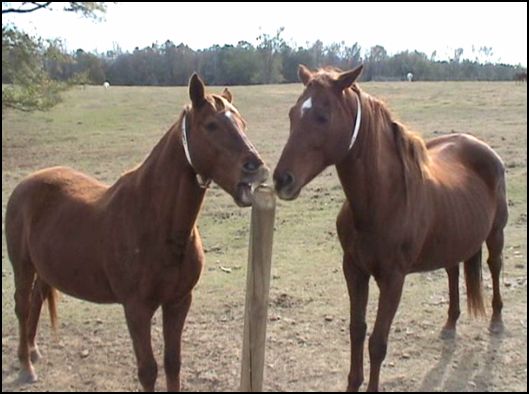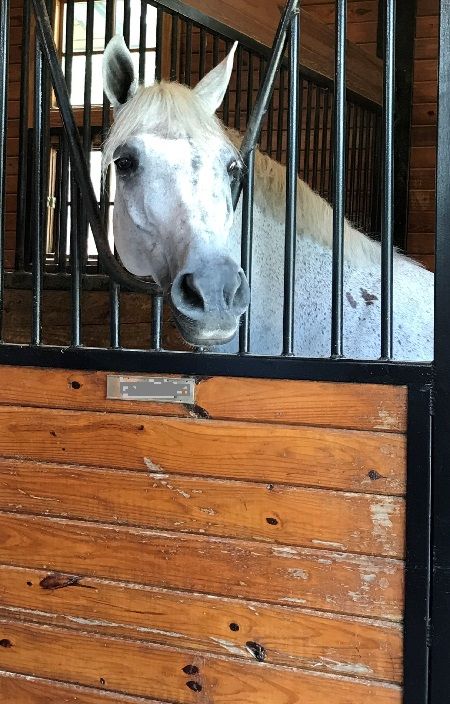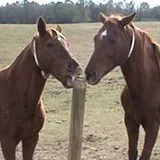Is it coping or is it a vice? Understanding stereotypic behaviors in horses
Introduction
Stereotypic behaviors are defined as repetitive, relatively unvarying patterns of behavior with no obvious goal or function. A horse that displays stereotypic behavior tends to perform the behavior in nearly the exact same way every time, and many horses also perform the behavior in a preferred location (e.g., in a specific area of the stall or paddock). This article will share what science has revealed about stereotypic behaviors, and how this information can be applied to better manage and thus improve the welfare of horses with stereotypic behavior. The information is intended for horse owners, equine facility managers, and county Extension agents.
Stereotypic behaviors are often referred to as “stable vices” and have been historically attributed to boredom. However, researchers are moving away from using this terminology to describe stereotypies. Recent research has demonstrated that stereotypic behaviors are not simply the result of boredom, and in many horses these behaviors have a physical or psychological basis. These behaviors are also not an attempt by the horse to be a nuisance to their owner and should not be considered to be the fault of the horse.
Oral Stereotypies
Most survey studies conducted to date suggest that 4%–5% of the average horse population engage in an oral stereotypic behavior, such as cribbing (also called crib-biting) or wind sucking (Wickens and Heleski 2010). The cribbing horse (cribber) places its front teeth on an object, such as a fence board, pulls back while sucking air inward, and then emits a grunting noise (Figure 1). Horses that engage in wind sucking behavior display a similar behavior pattern to cribbing, but they typically do not place their teeth on a fixed object. The frequency and duration of cribbing behavior often increases around the time of feeding, especially when horses exhibiting the behavior are consuming concentrates (grain meals).

Credit: Carissa Wickens, UF/IFAS
Locomotor Stereotypies
There are two common locomotor stereotypic behaviors observed in horses. One is called weaving, where horses shift their weight back and forth on their front legs (in a repetitive, side-to-side swaying motion). A horse exhibiting this behavior often performs it when standing at the front of the stall or next to a paddock gate. The behavior often coincides with anticipation (e.g., while awaiting morning turnout or feed). The second locomotor stereotypic behavior is called box walking or stall walking, and it literally means to walk part or all of the horse’s box stall (or paddock) perimeter.
Risk Factors for Developing Stereotypic Behaviors
Although direct cause-and-effect research on this topic remains limited, multiple studies involving thousands of horses have consistently found the following factors to be associated with increased likelihood of engaging in a stereotypic behavior (Wickens and Heleski 2010):
- Insufficient/limited turnout time.
- Insufficient/limited opportunities to socialize with other horses.
- Insufficient/limited grazing or foraging opportunities—this factor often goes together with high-concentrate diets, which have also been implicated.
- Stressful weaning, particularly an abrupt method with individual housing.
There is evidence that young, growing horses with gastric ulcers are more likely to be crib-biters. In one study, treating underlying gastric disease tended to reduce the amount of time horses spent cribbing (Nicol et al. 2002). Differences in brain physiology responsible for goal-directed and reward-seeking or facilitated behavior have also been demonstrated between horses with stereotypic behavior and horses that do not show these behaviors. For example, in learning experiments, horses that crib-bite demonstrate a strong motivation to perform the behavior (i.e., cribbing horses will work to achieve access to a cribbing surface). Compared to non-stereotypic horses, horses that exhibit stereotypic behaviors are slower to reduce their frequency of responding when they are no longer receiving reinforcement (e.g., food rewards) for performing the desired task (e.g., pressing a lever to access a food reward).
Additional risk factors for stereotypic behaviors include sex (stallions are more prone to engage in stereotypic behaviors), stressful riding disciplines or frequent competition, genetics, and recovery from recent illness or injury. In many of these scenarios, careful assessment of the horse’s environment and management will also reveal suboptimal turnout time, social interaction, or foraging opportunities.
Commonly Held Beliefs
Contrary to common belief, there is no scientific evidence that horses learn stereotypic behaviors from one another. Anecdotally, when stereotypic horses are turned out to pasture with non-stereotypic horses (i.e., those horses that do not display a stereotypic behavior), the non-stereotypic horses do not mimic the stereotypic behaviors. However, there is less consistent evidence when it comes to housing non-stereotypic horses next to or across from stereotypic horses in environments with known risk factors for stereotypic behaviors. Further research is needed to better understand if horses are learning behaviors from each other, or if they are simply responding to the same environmental stressors.
Should I try to stop the behavior? If so, how?
If you own or manage a horse with a stereotypic behavior, learn as much as possible about that behavior. New research findings are becoming available all the time. Stereotypic behaviors are recognized as both a welfare and a management concern, and of primary importance is whether an owner should take steps to prevent the horse from performing the behavior. Attempts to physically prevent stereotypic behaviors may result in increased psychological stress for the horse and additional strain on the owner’s pocketbook. Always remember that somewhere along the way, the horse developed this stereotypic behavior because it was likely trying to “cope” with a suboptimal husbandry situation. If we view it as a coping mechanism, how certain are we that we should take away the horse’s ability to cope? Multiple studies have shown, when presented with a stressor, the horses that handled it least well were crib-biters that were prevented from cribbing; non-cribbers handled the stressor decently, and cribbers allowed to crib also handled the stressor decently. However, cribbers that were thwarted were more stressed. Therefore, strategies aimed at addressing the behavior should include consideration of potential causal factors and implementation of management practices known to help reduce the behavior by increasing the horse’s well-being and lowering stress (e.g., increased opportunities to socialize with other horses and to graze/consume forage).
Some horses will engage in their stereotypic behavior to the point where the behavior reduces their time spent consuming adequate feedstuffs to maintain a desired body condition. With respect to cribbing, some owners have had success with various cribbing collars and/or anti-cribbing muzzles. Care should be taken when turning horses out because many of the collars do not have breakaway mechanisms in the event of entanglement. Even a well-fitted collar or muzzle will often create lesions on the horse’s head, potentially resulting in sensitivity around the poll. Collars must be properly fitted and kept clean. Use of fleece covers can help make the collar more comfortable for the horse.
With respect to the locomotor stereotypies, some owners have had success in reducing their horse’s weaving or box-walking by increasing the visual horizons (e.g., placing the horse in a stall with a window to the outdoors or with an acrylic/shatterproof mirror, adding an anti-weave stall front that allows the horse to have its head and neck out to the aisle [Figure 2]) or simply providing the horse with increased turnout time. Based on the authors’ experience and anecdotal reports from owners, it appears much easier to reduce the time a horse spends engaged in a locomotor stereotypie compared to an oral stereotypic behavior.

Credit: Carissa Wickens, UF/IFAS
Consult your Veterinarian
Pain is stressful for both people and animals, and it is important to consult with your veterinarian to ensure that your horse’s stereotypic behaviors are not a response to illness or injury. If your horse has developed a stereotypic behavior during stall confinement due to a recent surgery or injury (stall weaving and pawing are particularly common for horses on stall rest), your veterinarian may be able to prescribe a safe sedative to help your horse cope with confinement and reduced exercise during its recovery period.
Conclusion
Just because your horse performs a stereotypic behavior, such as cribbing or weaving, does not mean its current state of welfare is suboptimal. It is more likely that at some point in the horse’s history, the horse was trying to cope with stressors outside the behavioral demands of its nature. Managing stereotypic behaviors can be challenging. The best management strategy continues to be prevention by trying to optimize turnout time, social interaction, and grazing/foraging opportunities. Minimizing stress during the weaning process is important, and working hard to enhance natural behaviors when horses are on stall rest for injuries or illness can help reduce the chance that your horse will develop a stereotypic behavior.
References
Nicol, C. J., H. P. D. Davidson, P. A. Harris, A. J. Waters, and A. D. Wilson. 2002. “Study of Crib-Biting and Gastric Inflammation and Ulceration in Young Horses.” Veterinary Record 151:658–662. https://doi.org/10.1136/vr.151.22.658
Wickens, C. 2013. “Is it coping or is it a vice? A review of cribbing, weaving, and other stereotypic behaviors in horses.” My Horse University, January 2013 Webcast. https://www.myhorseuniversity.com/single-post/2013/01/22/Is-it-Coping-or-is-it-a-Vice-A-Review-of-Cribbing-Weaving-and-Other-Stereotypic-Behaviors
Wickens, C. L., and C. R. Heleski. 2010. “Crib-Biting Behavior in Horses: A Review.” Applied Animal Behaviour Science 128:1–9. https://doi.org/10.1016/j.applanim.2010.07.002




